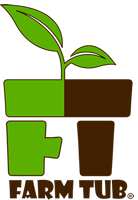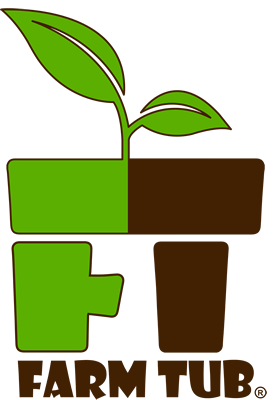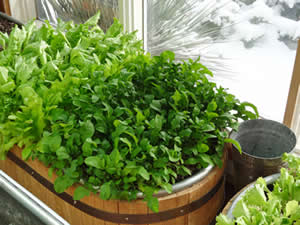What is a Farm Tub Planter and how does it work?
Farm Tub Planters are custom-built planters and growing systems for home and garden. Farm Tub Planters come in galvanized steel finish and utilize a water reservoir and capillary wick system. DIY conversion kits are available as well to add self-watering to an existing planter or stock tank.
What is the difference between a complete Farm Tub and a Farm Tub DIY Kit?
A Farm Tub DIY Self-Watering Kit is the growing system component of a Farm Tub Planter and allows you to convert any water-holding planter or tank into a self-watering planter. A Farm Tub Planter includes the tank and self-watering system.
What is a self-watering planter and what are some advantages?
Self-watering is a gardening industry term for a system where water is delivered to the root zone, so plants take in the water they need through the roots. In the case of Farm Tub, we refer to it as a growing system. The advantage of this system is that there is less evaporation, it minimizes the loss of nutrients that can wash out of soil in top watering, and there is limited compaction so complex root systems can form.
What materials are used in a Farm Tub self-watering system and kit?
Farm Tub growing systems utilized food grade HDPE and PP plastics, as well as wool wicks.
How often do you need to fill a Farm Tub reservoir and how much water does it take?
The frequency of filling the reservoir is dependent on location, conditions and what plants are growing in your Farm Tub Planter. A conservative estimate, even for tomatoes in summer heat is to fill the reservoir every week to 10 days.
Each size is different but the approximate amount of water needed to fill a reservoir is as follows: 2x2x3 ft – 14 gallons, 2x2x4 ft – 17 gallons, 2x2x5 ft – 23 gallons, 2x2x6 ft – 28 gallons, 3x2x8 ft – 56 gallons and 3×2 ft round – 21 gallons.
What type of potting soil should you use in a Farm Tub growing system and how much soil does each planter take?
For effectiveness, the system requires the use of a high-grade potting soil, such as Black Gold Natural and Organic Potting Soil. Do not use compost, clay or sandy soil.
The potting soil requirements for stock tanks using the Farm Tub system are as follows: 2x2x3 ft – 10 cubic feet, 2x2x4 ft – 14 cubic feet, 2x2x5 ft – 17.5 cubic feet, 2x2x6 ft – 20 cubic feet, 3x2x8 ft – 40 cubic feet and 3×2 ft round – 13-14 cubic feet
Can you paint a galvanized planter and does it need a primer?
Yes you can. We recommend you use a primer before painting. One recommended is XIM UMA Primer.
How often do wicks need to be replaced?
We recommend you replace your wicks every 5 years when you change out your potting soil. Wicks can be purchased from Farm Tub.
Do you sell individual replacement parts for planters and kits?
The following parts are available: Fill Tubes, Farm Tub Floats, spacers, wicks, and spigots. Please call for pricing.
Does Farm Tub do custom conversions of planters and what is the cost?
We do custom projects to convert existing planters and tanks for individuals and municipalities, primarily in Colorado. We also sell custom-sized components for such projects. Pricing is bid by project.
What sort of care is required on the wooden Farm Tub Planters?
Oiling or staining is recommended to preserve the wood and extend the life of the cedar veneer. You can also cover your tubs in winter weather.
What needs to be done to winterize a Farm Tub Planter?
Open the spigot to let water drain and remove and store your Farm Tub float. That’s it. Per above, you may choose to cover your tank in the winter.


